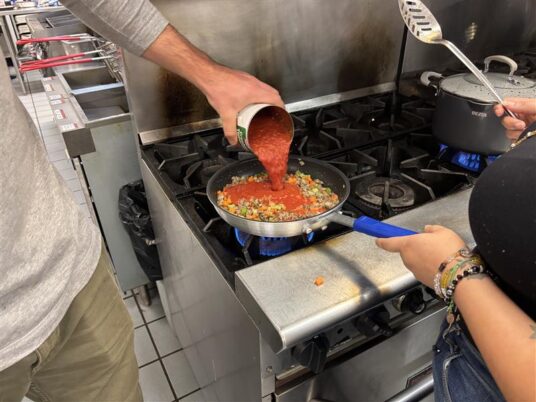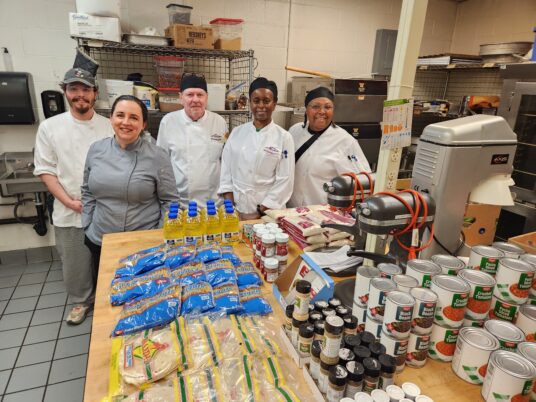Pantry to plate: New cooking class helps CPTC students stretch resources and build skills
By Jean Borst
Some of the best ideas are cooked up at the dinner table.
Whenever Shannon Kim’s son invited one of his good friends over for dinner, she noticed how excited he was about something many families take for granted – a home-cooked meal.
“He and his dad go to the store every night to buy prepared food because his dad doesn’t know how to cook,” said Kim, a Clover Park Technical College (CPTC) Culinary Arts instructor. “When he came to our house, he was really interested in learning how to make what we were eating. That really stuck with me.”
Those moments planted the seed for a new hands-on cooking class at CPTC, designed to help students who face food insecurity learn to make the most of what’s available.
“With food prices rising and so many people stretched thin, it got me thinking about how many young people don’t have those basic cooking skills at home,” Kim said. “And if you don’t know how to cook, you end up spending a lot more money.”
Turning an idea into action
Kim’s observations grew into a plan of action after attending a CPTC in-service day, where she learned that 41 percent of the college’s students qualify as low income.
“The combination of limited funds and limited cooking ability is a really tough place to be,” Kim said. “People deserve to have those basic skills, especially our students.”
Kim shared her idea with Cathy Purcella, CPTC’s senior executive director of Advancement & Strategic Communication. Together, they explored ways to bring it to life. A generous donor soon stepped forward to fund the pilot program, eager to support a fresh solution to an urgent need.
More than a meal
Kim led the first class on November 4 in the Culinary Arts building, welcoming 10 students. Working in pairs, they learned how to prepare three nutritious, budget-friendly dishes – pasta, a lentil dish and a wrap – using ingredients commonly found in CPTC’s Food Pantry boxes and the Nourish Pierce County Mobile Food Bank.

While participants were initially quiet and tentative, the kitchen soon turned into a lively, collaborative space.
“By the end, we were all chatting, laughing and having fun,” Kim said. “The best part for me was seeing students who didn’t think they could cook taste what they made. They just lit up.”
The class is free, and participants take home far more than new skills. They leave with about six servings of prepared meals, a pantry box with the same ingredients used in class, and a starter tool kit that includes a soup pot, sauté pan, mixing spoon, peeler, can opener and spices.
“We wanted to remove any barriers to recreating what they made in class,” Kim said.

Learning by teaching
The class doesn’t just benefit those learning to cook – it also gives CPTC’s Culinary Arts students real-world teaching experience. Several from the program volunteered to assist their instructor, helping attendees learn knife skills, kitchen safety, cooking terminology and step-by-step techniques. The experience also provided a glimpse into other ways to grow in the field and pursue high-wage careers outside of traditional restaurant kitchens, such as teaching or leading community classes.

For the student volunteers, the class was as enriching as it was educational:
- “I loved having the opportunity to see people come to appreciate home cooking as much as I do. Too often, I think we fall into the trappings of convenient foods and quick meals, while most decent meals made at home outshine any of those foods.” (Austin Nunn)
- “I’ve always enjoyed teaching people new things, which is something I did for many years working in the residential construction and remodeling field. It was a great event, and all the students were enthusiastic. I hope to see some of them in our program one day.” (Michael Adkins)
- “It was a great way to meet other students at CPTC and promote the Culinary Arts program. The class was a lot of fun, and I look forward to supporting the program and chef instructors.” (Kim Dudley)
Cooking up confidence and community
CPTC plans to offer the class quarterly during this pilot phase and hopes to expand the program with additional funding. Future sessions may include topics designed for more seasoned cooks, like roasting a whole chicken and using the leftovers to make stock.
For Cathy Purcella, launching and growing the class is another way CPTC continues to live out its mission to care for students far beyond the classroom.
“So many of our students are struggling because of food insecurity, and we’re doing everything we can to help,” she said. “We’re just so grateful Chef Kim thought of this and is volunteering her time to make it happen. It’s one more example of how our faculty care deeply about our students’ wellbeing.”
“These aren’t people who want to be chefs,” Kim said. “But everyone still needs to eat. Teaching these skills isn’t just about food – it’s about giving people confidence, dignity and a sense of community.”
Get a taste of what’s cooking in Chef Kim’s kitchen
Here are the three recipes cooking class participants prepared during the inaugural session: